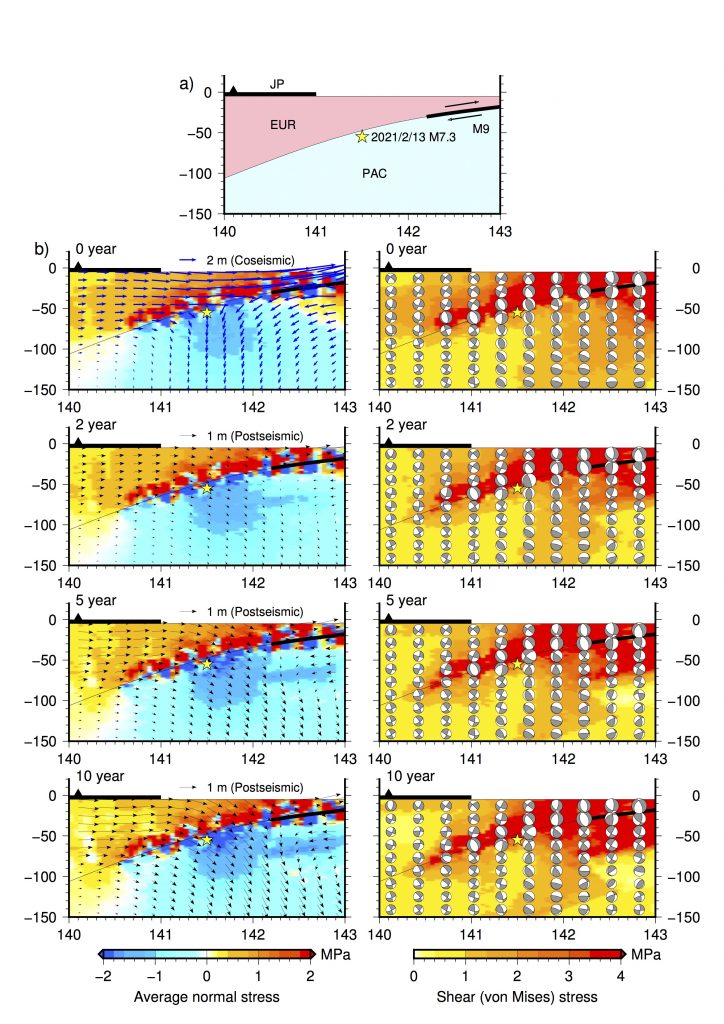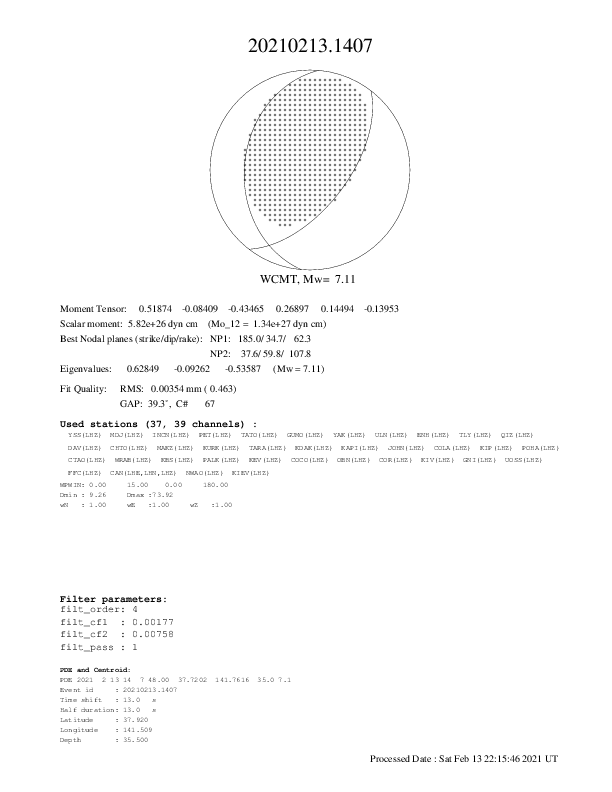Last updated : 16th February, 2021
Website launched: 14th February, 2021
An earthquake 7.3 Mw(according to JMA) occurred on 13th February 2021 at around 23:07 p.m. JST, off the coast of Fukushima Prefecture, northeast Japan.
*All figures/pictures/movies should be credited as: “Earthquake Research Institute, The University of Tokyo” when cited. Please report via contact form upon usage.
Stress loading on the 2021 M7.3 Fukushima-oki earthquake due to the 2011 M9 Tohoku-oki earthquake
<Figures are updated on 9th March, 2021>
On February 13, 2021, a Mj7.3 earthquake occurred off the coast of Fukushima (37.6°N, 141.5°E), with a maximum seismic intensity of upper 6 in both Fukushima and Miyagi prefectures. This earthquake is a reverse-fault type with east-west compression, and is considered as an intra-slab earthquake within the subducting Pacific plate. In order to reveal the generation mechanism of this earthquake, it is important to know how the 2011 M9 Tohoku-oki earthquake affected this earthquake.
Here, we plot the stress change around the hypocenter, based on the postseismic deformation model after the 2011 Tohoku-oki earthquake by Freed et al. (2017) and Becker et al. (2018). Freed et al. (2017) obtained the viscous structure under the Japanese islands and afterslip distribution based on the 3 years of postseismic deformation data since March 11, 2011. Based on this model, Becker et al. (2018) computed the time variation of the underground stress field.
Figure 1. shows the time variation of the stress field due to the Tohoku-oki earthquake in the cross section at latitude 38°N (the stress before the Tohoku-oki earthquake is assumed to be 0). The left column shows the average normal stress (σ11 + σ22 + σ33) / 3 with the crustal deformation vector, and the right column shows the von Mises stress with the stress pattern represented by focal mechanism symbols (lateral view). The average normal stress shows that the hanging-wall side is widely extensional, while the footwall side including the hypocenter is compressive. The von Mises stress and the focal mechanisms show that the shear stress increases by about 1 MPa with east-west compression around the source region. This stress change is consistent with the source mechanism of the Mj7.3 Fukushima-oki earthquake, which suggests that the 2011 Tohoku-oki earthquake triggered this earthquake.
In order to estimate the stress change with more accuracy, it is necessary to obtain a stress change model that includes the effects of viscoelastic relaxation and afterslip based on 10-year crustal deformation data.

(Akinori Hashima)
Reference:
- Freed, A. M., A. Hashima, T. W. Becker, D. A. Okaya, H. Sato, and Y. Hatanaka (2017), Resolving depth-dependent subduction zone viscosity and afterslip from postseismic displacements following the 2011 Tohoku-oki, Japan Earthquake, Earth Planet. Sci. Lett., 459, 279-290.
- Becker, T. W., A. Hashima, A. M. Freed, and H. Sato (2018), Stress change before and after the 2011 M9 Tohoku-oki earthquake, Earth Planet. Sci. Lett., 504, 174-184, doi:10.1016/j.epsl.2018.09.035.
W-phase mechanism
(Earthquake and Volcano Information Center : TSURUOKA Hiroshi)




